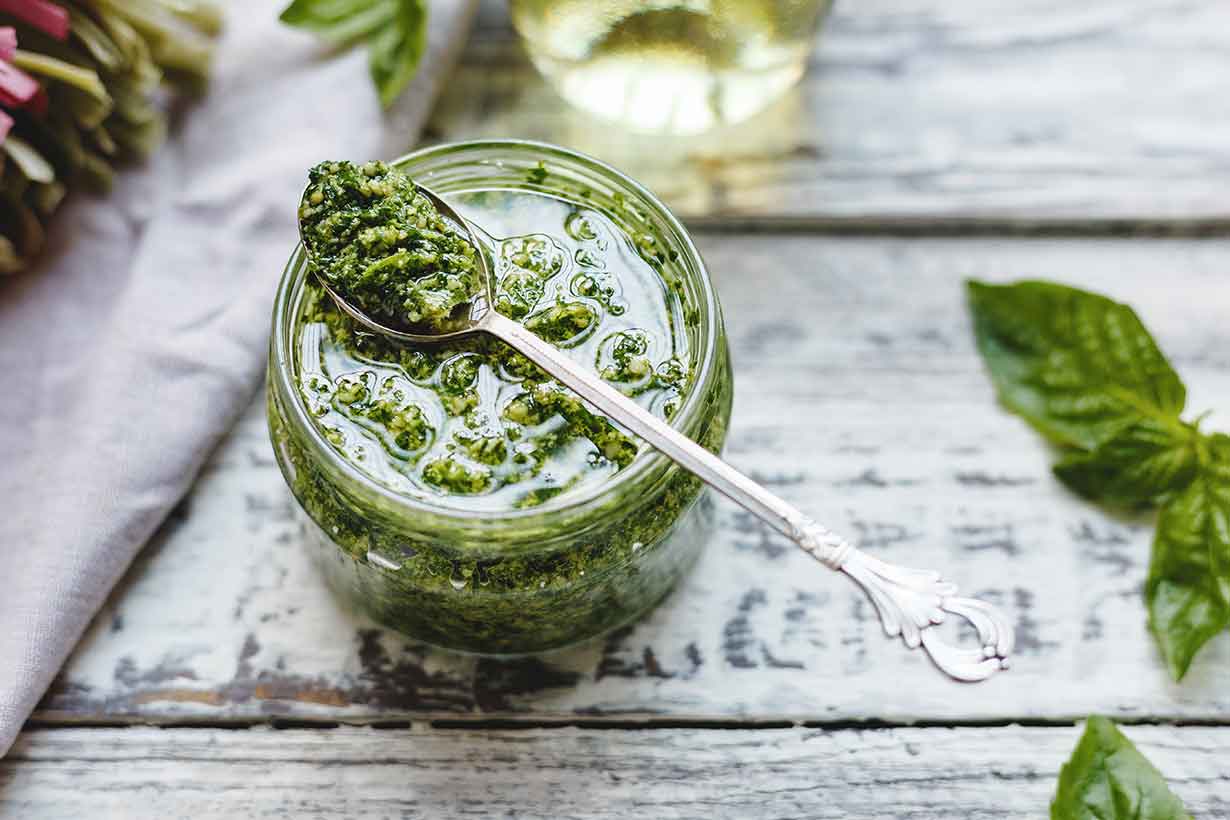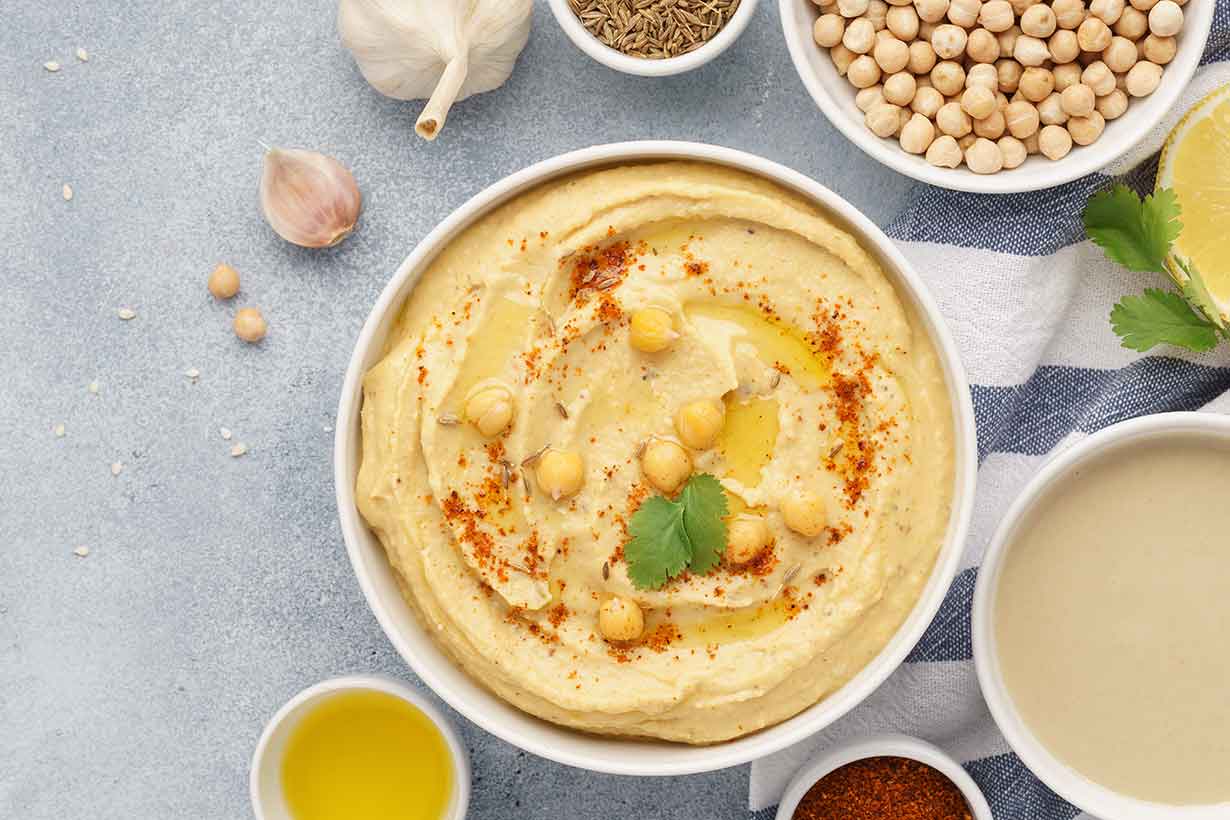Condiments are ingredients added to foods to enhance their flavor, and there are a wide variety available.
From simple spices to creamy dips and fermented sauces, they can add texture, deep flavors, and even nutritional value.
This in-depth guide provides a list of 37 popular condiments with information on their characteristics, uses, and key nutrition facts.
All nutritional data is sourced from USDA FoodData Central where available or the Nutritionix database.
Table of contents
High-Fat Spreads and Sauces
1) Aioli
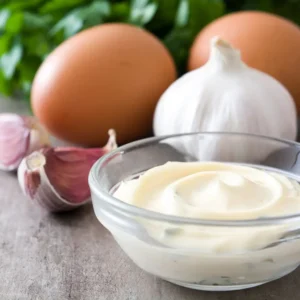
Aioli is a Mediterranean condiment that traditionally features a simple blend of egg yolk, garlic, olive oil, and salt. However, branded products may substitute other vegetable oils for olive oil, so check labels carefully if you desire a more traditional aioli.
This famous sauce has a creamy texture and lots of flavor, with the garlic a key to its overall taste.
Generally, aioli is served as a side with vegetables, meat, or olives, while also enjoying popularity as a dipping sauce.
A typical tablespoon serving of aioli offers the following nutritional values (1):
- Calories: 97 kcal
- Carbohydrate: 0.3 g
- Fiber: 0 g
- Sugars: 0 g
- Fat: 11 g
- Saturated fat: 1.5 g
- Protein: 0.3 g
- Sodium: 44 mg
2) Bearnaise Sauce

Bearnaise sauce is a traditional French sauce made by combining egg yolks with clarified butter and white wine vinegar. The sauce has strong flavors due to ingredients including pepper and tarragon.
Bearnaise sauce is traditionally served alongside meat or fish. According to Nutritionix, it typically provides the following nutritional values per 47-gram serving (2):
- Calories: 228 kcal
- Carbohydrate: 1.0 g
- Fiber: 0.2 g
- Sugars: 0.2 g
- Fat: 25 g
- Saturated fat: 15.0 g
- Protein: 1.4 g
- Sodium: 185 mg
3) Cream Cheese

Cream cheese is a fresh cheese produced from milk and cream. It offers many of the same benefits (like calcium) and downsides (high in sodium) as regular cheese.
Cream cheese is very versatile as a condiment, and we can use it as a topping on a wide variety of foods. It also works well as a spread in a similar way to butter, and it is particularly popular paired with foods like bagels and baked potatoes.
The typical nutritional profile for a 14.5-gram tablespoon of cream cheese is as below (3):
- Calories: 51 kcal
- Carbohydrate: 0.8 g
- Fiber: 0g
- Sugars: 0.5 g
- Fat: 5.0 g
- Saturated fat: 2.93 g
- Protein: 0.89 g
- Sodium: 45.5 mg
Learn more: Cream Cheese: Is It a Healthy Choice?
4) Hollandaise Sauce

Hollandaise sauce is another egg yolk and butter-based French condiment.
However, unlike bearnaise sauce, it traditionally contains lemon juice rather than vinegar, and it is mostly seasoned with salt.
This condiment can be used as a sauce to provide some extra flavor. It is also one of the primary ingredients in the French dish ‘eggs Benedict.’
Nutritionally, a 16-gram tablespoon of hollandaise sauce contains (4):
- Calories: 87 kcal
- Carbohydrate: 0.17 g
- Fiber: 0 g
- Sugars: 0.12 g
- Fat: 9.28 g
- Saturated fat: 4.84 g
- Protein: 0.86 g
- Sodium: 53 mg
5) Mayonnaise
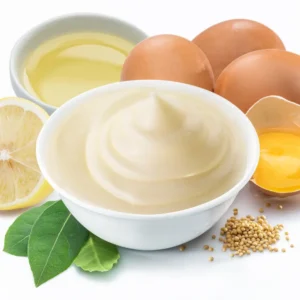
Mayonnaise is one of the most popular condiments in the world, featuring in everything from sandwiches and burgers to dips and salads.
Commonly known as mayo, it features an emulsion of oil, eggs, vinegar, and salt. It may also include additional ingredients like garlic or lemon, depending on the product.
Mayonnaise is very flavorful and tends to enhance the taste of food, providing added flavor and moisture. According to food history writers, mayonnaise likely originated in Spain before the 1700s but was later popularized by French cuisine (5).
Mayonnaise is widely available in regular and low-fat varieties. Here are the typical nutritional values for regular mayonnaise per 14-gram tablespoon (6):
- Calories: 94 kcal
- Carbohydrate: 0.08 g
- Fiber: 0 g
- Sugars: 0.08 g
- Fat: 10.3 g
- Saturated fat: 1.62 g
- Protein: 0.13 g
- Sodium: 87.6 mg
Learn more: Mayonnaise: Health Effects and Nutritional Properties
6) Nutella

Nutella is among the most famous sweet condiments, and people love to pair it with foods like pancakes and bread.
A typical two-tablespoon serving provides (7):
- Calories: 200 kcal
- Carbohydrates: 22.0 g
- Fat: 11.0 g
- Protein: 2.0 g
Learn more: Nutella: Is It a Good Choice Nutritionally?
7) Peanut Butter

Although some people might not think of peanut butter as a condiment, much of the world does.
In the West, peanut butter is typically a sandwich-filling, but in Asian countries like Thailand and Vietnam, it often features as part of dips and cooked dishes.
Some famous foods that use peanut butter in this way include Thai peanut chicken and noodles in peanut sauce.
Peanut butter has a reasonably good nutrient profile, and it is rich in protein, fats, and a variety of vitamins and minerals.
A 32-gram, two-tablespoon serving of chunk style peanut butter offers (8):
- Calories: 188 kcal
- Carbohydrate: 6.91 g
- Fiber: 2.56 g
- Sugars: 2.69 g
- Fat: 16.0 g
- Saturated fat: 2.44 g
- Protein: 7.71 g
- Sodium: 156 mg
8) Pesto

Pesto is a flavorful Italian sauce which is traditionally uncooked made from a mix of garlic, pine nuts, basil, Parmesan cheese, salt, and olive oil.
Pesto often features as a dip, spread, or sauce. It is a versatile condiment and common usages include pasta, pizza, and salads.
Due to its ingredients including cheese, nuts, and added salt, pesto is quite high in fat and sodium. A 62-gram, quarter-cup serving of basil pesto provides these nutritional values (9):
- Calories: 231 kcal
- Carbohydrate: 4.3 g
- Fiber: 1.3 g
- Sugars: 1.61 g
- Fat: 22.6 g
- Saturated fat: 4.17 g
- Protein: 2.58 g
- Sodium: 639 mg
Learn more: What Is Basil Pesto? A Complete Guide
9) Sour Cream

Sour cream is another condiment popular condiment with a wide variety of uses. For example, it is an iconic ingredient in several Mexican foods, often combined with salsa and guacamole.
However, Mexican food is far from the only way to use sour cream. For more ideas, mixing thickened sour cream with several herbs makes a simple but flavorful sauce to top a variety of savory meals.
Like other dairy products, sour cream is available in regular full-fat varieties as well as low-fat options.
Each 12-gram tablespoon of sour cream offers the following nutritional values (10):
- Calories: 24 kcal
- Carbohydrate: 0.56 g
- Fiber: 0 g
- Sugars: 0.41 g
- Fat: 2.33 g
- Saturated fat: 1.21 g
- Protein: 2.9 g
- Sodium: 3.72 mg
Learn more: Sour Cream: Nutrition, Benefits, Downsides
10) Tahini

Tahini is a protein and fat-rich condiment typically used as a flavorful dip, spread, or topping.
Over the years, tahini has been a traditional food in North Africa, the Middle-East, and some parts of the Mediterranean. Tahini’s simplicity is another reason for its popularity, requiring only sesame seeds, olive oil, and a bit of salt.
Per 15-gram tablespoon serving, tahini typically offers these nutritional values (11):
- Calories: 89 kcal
- Carbohydrate: 3.18 g
- Fiber: 1.4 g
- Sugars: 0.07 g
- Fat: 8.07 g
- Saturated fat: 1.13 g
- Protein: 2.55 g
- Sodium: 17 mg
Learn more: Is Tahini a Healthy Choice? Nutrition, Benefits, Downsides
Spicy Chili-Based Dips and Pastes
11) Gochujang

Gochujang is a Korean fermented condiment made from spicy peppers, salt, fermented soy, rice vinegar, and small amounts of glutenous rice.
The English translation of gochujang is red chili paste, and it has a thick paste-like consistency.
Gochujang has a mildly sweet, salty, and spicy flavor, and it is ubiquitous in Korean food. It is a common ingredient in everything from rice dishes and vegetable side dishes to seafood and meat stews.
Per 5-gram teaspoon, gochujang offers the following nutrient profile (12):
- Calories: 10 kcal
- Carbohydrate: 2 g
- Fiber: 0 g
- Sugars: 1.5 g
- Fat: 0 g
- Saturated fat: 0 g
- Protein: 1 g
- Sodium: 32 mg
12) Harissa
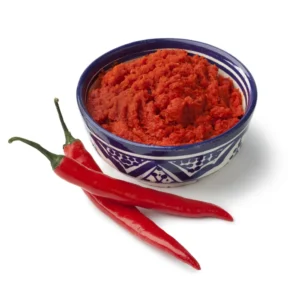
Harissa is another type of hot chili paste formed from an ingredients profile of chili peppers, garlic, olive oil, and various toasted spices.
This spicy paste originates from North Africa, where it is a staple ingredient. It also carries the tag of ‘Tunisia’s national condiment’ (13).
As well as featuring in soups and stews, people use harissa as a dip or for marinating meats, vegetables, and seafood.
Here are the typical nutritional values for a 14-gram tablespoon of harissa (14):
- Calories: 39 kcal
- Carbohydrate: 4.1 g
- Fiber: 1.5 g
- Sugars: 2.1 g
- Fat: 2.6 g
- Saturated fat: 0.4 g
- Protein: 0.6 g
- Sodium: 204 mg
Learn more: Harissa Paste: Ingredients, Nutrition, and Uses
13) Hot Sauce

There are many different versions of hot sauce, from sriracha to ultra-hot sauces that provide a spicy challenge.
However, most options have similar base ingredients, with chili peppers, vinegar, and salt prominently featuring.
Hot sauce works well as a dip or drizzled on top of food, and it can add some flavor to a wide variety of dishes.
A typical 6.5g teaspoon serving of hot sauce provides (15):
- Calories: 6 kcal
- Carbohydrate: 1.25 g
- Fiber: 0.14 g
- Sugars: 0.98 g
- Fat: 0.06 g
- Protein: 0.13 g
- Sodium: 138 mg
Hot sauce is a rich source of capsaicin, which may potentially have some health benefits (16).
Learn more: Is Hot Sauce Healthy? Nutrition, Benefits, and Drawbacks
14) Muhammara

Muhammara is another spicy paste-like condiment used as a dip, and this one hails from the Middle East.
To be specific, Syria is thought to be the origin of muhammara.
This spicy dip has an interesting ingredients profile, containing a diverse range of foods, including walnuts, lemon juice, pomegranate, red chili peppers, olive oil, salt, and spices (17).
With ingredients like walnuts, olive oil, chili peppers, and pomegranate, muhammara provides a range of vitamins, minerals, and fats.
Here is the typical nutritional profile of muhammara per 28-gram, two-tablespoon serving (18):
- Calories: 100 kcal
- Carbohydrate: 6 g
- Fiber: 2 g
- Sugars: 1 g
- Fat: 8 g
- Saturated fat: 1.0 g
- Protein: 2 g
- Sodium: 115 mg
15) Salsa

Salsa is a delicious Mexican condiment traditionally made from ingredients like tomatoes, onion, garlic, cilantro, lime juice, and salt.
Salsa is often used as an ingredient in wraps, and it also enjoys popular use as a dip—particularly with snack foods like tortilla chips.
Commercial salsa products may contain added oils and sugars, so check labels carefully if you prefer a traditional recipe.
A typical 36-gram, two-tablespoon serving of salsa provides the following nutrients (19):
- Calories: 10 kcal
- Carbohydrate: 2.39 g
- Fiber: 0.68 g
- Sugars: 1.44 g
- Fat: 0.06 g
- Saturated fat: 0.01 g
- Protein: 0.55 g
- Sodium: 256 mg
Learn more: What Is Salsa and Is It Healthy?
16) Ssamjang

Ssamjang is another paste-like condiment from Korea, and it contains a wide range of ingredients. The ingredients include gochujang, fermented soybean paste, sesame oil, garlic, onion, and, depending on the brand, sugar.
With this range of ingredients, Ssamjang has an interesting flavor that is salty, spicy, and mildly sweet at the same time. Traditionally, ssamjang is used as a dipping sauce for raw vegetables and cooked meat.
Per 20-gram tablespoon serving, ssamjang offers the following nutritional values (20):
- Calories: 40 kcal
- Carbohydrate: 7 g
- Fiber: 0 g
- Sugars: 4 g
- Fat: 0.5 g
- Saturated fat: 0 g
- Protein: 2 g
- Sodium: 480 mg
With a sodium content of 480 mg, ssamjang is among the highest-sodium condiments.
Fermented and Umami Sauces
17) Coconut Aminos

Coconut Aminos is a unique and relatively new condiment marketed as a soy sauce alternative. To make it, the producers combine coconut tree sap with sea salt and allow it to age.
While it looks like soy sauce and shares a slightly similar salty flavor, it has its own distinct flavor, with slight hints of sweetness.
Overall, it works well as a substitute for soy sauce, but it might not be the right fit for someone who enjoys the stronger flavor that traditional soy sauce offers.
A 5 ml teaspoon serving of Coconut Aminos has the following nutritional values (21):
- Calories: 40 kcal
- Carbohydrate: 2.0 g
- Fiber: 0 g
- Sugars: 1.7 g
- Fat: 0 g
- Saturated fat: 0 g
- Protein: 0 g
- Sodium: 66 mg
Learn more: What Is Coconut Aminos? A Tasty Soy Sauce Substitute
18) Fish Sauce

Fish sauce is a flavor-enhancing condiment that enjoys popularity in East and South-East Asia.
While fish sauce sometimes features in recipes, it is also popular as a dip, especially in Thai and Vietnamese cuisine.
The sauce has a liquid consistency similar to soy sauce, and it offers a complex flavor, which is both salty and pungent. Producing fish sauce involves salting and then fermenting fish—often anchovies—for 1-2 years (22).
Fish sauce contains a significant amount of salt, so it may be unsuitable for individuals trying to lower their sodium intake.
Nutritionally, a typical 18-gram tablespoon serving of fish sauce contains (23):
- Calories: 6 kcal
- Carbohydrate: 0.66 g
- Fiber: 0 g
- Sugars: 0 g
- Fat: <0.01 g
- Saturated fat: <0.01 g
- Protein: 0.91 g
- Sodium: 1413 mg
Learn more: Fish Sauce: Nutrition, Benefits, Downsides, and More
19) Kimchi

Kimchi is one of several fermented cabbage-based foods, but it is very different in taste to options like sauerkraut. While sauerkraut is a simple blend of cabbage and salt, this spicy Korean side dish contains a whole host of pungent ingredients.
In this regard, a typical kimchi recipe contains napa cabbage, red pepper flakes, garlic, fish sauce, ginger, and salt—a wide range of bold flavors.
There are dozens of different kimchi varieties, and it may include vegetables such as green onions, chives, radish, cucumber, and more.
However, a regular store-bought kimchi will offer the following typical nutritional values per 30-gram serving, which is approximately two tablespoons (24):
- Calories: 5 kcal
- Carbohydrate: 0.7 g
- Fiber: 0.5 g
- Sugars: 0.32 g
- Fat: 0.15 g
- Saturated fat: 0.02 g
- Protein: 0.33 g
- Sodium: 149 mg
Learn more: What Is Kimchi and What Health Benefits Does It Have?
20) Ponzu Sauce

Ponzu sauce is a popular condiment from Japan that combines soy sauce with several other ingredients, including citrus juice, vinegar, and mirin, a sweet rice wine.
The sauce has an enjoyable and flavorful taste, with flavor notes of umami, sweetness, and sour.
In addition to its popular use as a dip, ponzu also features as a flavor-enhancing ingredient in a wide range of dishes.
Per 16g tablespoon, ponzu sauce typically has the following nutritional values (25):
- Calories: 10 kcal
- Carbohydrate: 1.9 g
- Fiber: <0.1 g
- Sugars: 1.53 g
- Fat: <0.1 g
- Saturated fat: <0.01 g
- Protein: 0.60 g
- Sodium: 400 mg
Learn more: What Is Ponzu Sauce? Characteristics, Nutrition Facts, Uses
21) Sauerkraut

Sauerkraut is a popular condiment made from fermented cabbage. People typically consume a spoon or two of sauerkraut alongside their main meal.
While sauerkraut is very popular in Germany, it is thought to have originated in China. In fact, Genghis Khan has been credited with bringing sauerkraut to Europe during the Mongolian conquests.
Sauerkraut has a refreshing, slightly sour flavor and a crunchy texture. Per standard 30 gram serving, sauerkraut provides the following nutrients (27):
- Calories: 12 kcal
- Carbohydrate: 1.25 g
- Fiber: 0.84 g
- Sugars: 0.52 g
- Fat: 0.76 g
- Saturated fat: 0.32 g
- Protein: 0.27 g
- Sodium: 198 mg
Learn more: Sauerkraut 101: Nutrition Facts and Potential Benefits
22) Soy Sauce
Soy sauce is among the world’s most popular condiments, especially in Eastern Asian cuisine.
Soy sauce is typically made with water, fermented soybeans, and salt. However, it may also contain additional ingredients like wheat, sugar, and MSG.
Due to its versatility, soy sauce features in everything from noodle and rice dishes, marinades, and as a dip for sushi.
It is important to note that the nutritional values of soy sauce can vary widely depending on its specific ingredients profile. However, soy sauce made with water, soybeans, salt, and possibly wheat has the following typical nutritional values per 18-gram tablespoon (28):
- Calories: 11 kcal
- Carbohydrate: 1.0 g
- Fiber: 0.14 g
- Sugars: 0.31 g
- Fat: 0.02 g
- Saturated fat: <0.01g
- Protein: 1.89 g
- Sodium: 1010 mg
Note: Due to soy sauce’s high sodium content, it is important to use it sparingly.
Acidic Condiments
23) Apple Cider Vinegar
Apple cider vinegar is a very sour-tasting vinegar that works well in various recipes, offering a tangy flavor and mouthfeel benefits as a tenderizing agent. The sourness of apple cider vinegar comes from its high acetic acid content.
Notably, a 2025 systematic review of 7 controlled trials found that apple cider intake may help lower fasting blood sugar in individuals with type 2 diabetes (29). However, the authors advised that more research is neccessary to better understand these potential effects.
Nutritionally, a 15 ml tablespoon of apple cider vinegar provides the following values (30):
- Calories: 0 kcal
- Carbohydrate: 1 g
- Fiber: 0 g
- Sugars: 0 g
- Fat: 0 g
- Saturated fat: 0 g
- Protein: 0 g
- Sodium: 0 mg
24) Coconut Vinegar
Coconut vinegar is a perhaps lesser-known variety of vinegar.
Like other vinegars, it has an acidic and slightly sweet and sour taste profile, adding an exciting flavor to food.
Similar to all concentrated vinegar products, coconut vinegar is not a significant source of calories or nutrients. A 15 ml tablespoon typically provides (31):
- Calories: 0 kcal
- Carbohydrates: 0 g
- Fiber: 0 g
- Sugars: 0 g
- Fat: 0 g
- Saturated fat: 0 g
- Protein: 0 g
- Sodium: 0 g
Learn more: Coconut Vinegar: What is It and What Are the Health Benefits?
25) Lemon Juice
Lemon juice has a strong taste, adding both sweet and sour flavor notes to food. In some cuisines—such as Thai and Vietnamese cuisine—lemons play a key role in various national dishes.
Lemon juice can be an ingredient, drizzled on top of foods as a condiment, and used in drinks. However, it is strongly acidic, and a little goes a long way.
Nutritionally, lemon juice is a significant source of vitamin C. It also provides the following nutritional values per 30.5-gram fluid ounce (32):
- Calories: 7 kcal
- Carbohydrate: 2.1 g
- Fiber: 0.09 g
- Sugars: 0.77 g
- Fat: 0.07 g
- Saturated fat: 0.01 g
- Protein: 0.11 g
- Sodium: 0.31 mg
26) Malt Vinegar

Malt vinegar is perhaps most famous for its use in one of the United Kingdom’s national dishes: fish and chips.
The process of making malt vinegar involves fermented barley into ale, which then has its alcohol converted to acetic acid via the use of acetic acid bacterial cultures.
Compared to lighter vinegars like white vinegar and apple cider vinegar, malt vinegar has a bolder, arguably more flavorful taste. For this reason, it works exceptionally well as a condiment drizzled on top of food.
Like other vinegars, malt vinegar is non nutritive. A 15 ml tablespoon of malt vinegar has nutritional values as follows (33):
- Calories: 0 kcal
- Carbohydrate: 0 g
- Fiber: 0 g
- Sugars: 0 g
- Fat: 0 g
- Saturated fat: 0 g
- Protein: 0 g
- Sodium: 0 mg
27) Red Wine Vinegar
Red wine vinegar works well as a condiment for its somewhat fruity and tangy flavor, and for its ability to break down and tenderize food like meat.
As with all vinegar, red wine vinegar is generally considered to be a non-nutritive product.
According to USDA data, it has the following nutritional values per 15-gram tablespoon serving (34):
- Calories: 3 kcal
- Carbohydrates: 0.04 g
- Fiber: 0 g
- Sugars: 0 g
- Fat: 0 g
- Saturated fat: 0 g
- Protein: 0.01 g
- Sodium: 1.19 mg
Learn more: 7 Health Benefits of Red Wine Vinegar (and How to Make It)
Plant-Based Spreads and Dips
28) Guacamole
Avocados have some notable nutritional benefits, but another reason to praise them is that they provide us with guacamole.
Guacamole is a Mexican condiment available in many different varieties, but the traditional recipe has three base ingredients: avocado, salt, and lime juice. Among its uses, guacamole works well as a dip or an ingredient in foods like wraps.
Like whole avocados, guacamole provides a wealth of unsaturated fat, fiber, and high levels of potassium, vitamin C, and B vitamins.
Here are the nutrition facts for a typical 15-gram tablespoon of guacamole (35):
- Calories: 23 kcal
- Carbohydrate: 1.27 g
- Fiber: 0.98 g
- Sugars: 0.11 g
- Fat: 2.13 g
- Saturated fat: 0.31 g
- Protein: 0.29 g
- Sodium: 51.6 mg
Learn more: Is Guacamole Healthy and How Does It Compare To Avocado?
29) Hummus
Hummus is a tasty traditional dish originating from the Middle East.
It is also quite nutrient-rich for a condiment, providing a wide range of vitamins and minerals in addition to protein, fiber, and unsaturated fats.
A 15-gram tablespoon of hummus typically provides (36):
- Calories: 27 kcal
- Carbohydrate: 3.02 g
- Fiber: 0.6 g
- Sugars: 0.04 g
- Fat: 1.29 g
- Saturated fat: 0.17 g
- Protein: 0.73 g
- Sodium: 36.3 mg
Traditionally, people use hummus as a dip, but there is also a wide range of recipes that feature hummus.
Learn more: What Is Hummus? Nutrition Benefits and How To Use It
30) Kyopolou
Kyopolou is a paste-like spread thought to originate in Bulgaria that enjoys popularity throughout Eastern Europe and Turkey.
The primary ingredients in kyopolou are roasted eggplants and garlic, but it may contain additional ingredients like bell peppers, tomatoes, salt, and onions.
As the ingredients show, kyopolou features several healthy whole foods, making it a nutrient-rich choice of condiment.
Unfortunately, reputable nutrition databases like the USDA have not published nutritional values for this lesser-known spread.
It can be hard to find kyopolou, but it is relatively easy to make at home; there is an excellent recipe available here.
31) Sesame Oil
Sesame oil is unique among vegetable oils in the way that it adds a delicious flavor to almost anything you add it to.
For this reason, numerous Asian dishes contain a small amount of sesame oil (often added near the end of cooking) to enhance the flavor.
As a condiment, sesame oil is arguably the best-tasting oil.
A 13.6-gram tablespoon of sesame oil has these typical nutritional values (37):
- Calories: 120 kcal
- Carbohydrate: 0 g
- Fiber: 0 g
- Sugars: 0 g
- Fat: 13.6 g
- Saturated fat: 1.93 g
- Protein: 0 g
- Sodium: 0 mg
Learn more: Sesame Oil: Nutrition Facts, Health Benefits and Concerns
Other Popular Condiments
32) Ketchup
Ketchup is among the world’s most popular condiments, typically used as a topping on fries.
It could be described as an extra sweet, sour, and salty tomato paste from the ingredients combination of tomatoes, sugar, vinegar, and salt.
Per tablespoon (17g) serving, ketchup provides (38):
- Calories: 17 kcal
- Carbohydrate: 4.66 g
- Fiber: 0.05 g
- Sugars: 3.62 g
- Fat: 0.02 g
- Saturated fat: <0.01 g
- Protein: 0.17 g
- Sodium: 154 mg
Ketchup is also an excellent source of lycopene—a carotenoid with antioxidant properties (39).
Learn more: Is Ketchup Healthy? Nutrition, Benefits, and Drawbacks
33) Mustard
Found in everything from hot dogs to salad dressings, mustard is one of the most common condiments. It has a deep, flavorful, and slightly spicy taste.
Mustard is made with the seeds of the mustard plant and typically comes in two varieties:
- Whole grain: This variety contains the whole mustard seeds. It has a slightly stronger flavor than American yellow mustard, which may be positive or negative depending on personal preference.
- Yellow mustard: Yellow mustard comes in several forms, including ‘English mustard’ and ‘American mustard.’ American mustard is relatively mild and contains a higher vinegar content, whereas English mustard is hot and spicy.
A 5-gram teaspoon of prepared yellow mustard has the following nutritional profile (40):
- Calories: 3 kcal
- Carbohydrate: 0.29 g
- Fiber: 0.2 g
- Sugars: 0.05 g
- Fat: 0.17 g
- Saturated fat: 0.01 g
- Protein: 0.19 g
- Sodium: 55 mg
Learn more: What Is Prepared Mustard? A Complete Guide
34) Monosodium Glutamate
Monosodium glutamate is better known by its widely recognized abbreviation: MSG. It is a type of salt formed by bonding sodium with an amino acid called glutamate.
Due to its “umami” taste properties, MSG enjoys popularity as an ingredient or condiment for enhancing the natural flavors of savory food.
Per quarter-teaspoon (1g) serving, MSG provides (41):
- Calories: 0 kcal
- Carbohydrate: 0 g
- Fat: 0 g
- Protein: 0 g
- Sodium: 125 mg
Learn more: Is MSG Bad For You? Separating Fact From Fiction
35) Wasabi
Wasabi is a green-colored Japanese condiment that people often enjoy in combination with sashimi or sushi.
It is also great for adding a “kick” in terms of heat/spice to any food—it is among the most potent condiments.
In this regard, if you eat just a little too much, you’ll feel a burning sensation in the nose. This is due to wasabi’s high concentration of a compound called Allyl isothiocyanate (42).
A 6.5-gram teaspoon of wasabi has the following nutritional profile (43):
- Calories: 19 kcal
- Carbohydrate: 3 g
- Fiber: 0.4 g
- Sugars: 0.86 g
- Fat: 0.71 g
- Saturated fat: 0.13 g
- Protein: 0.15 g
- Sodium: 220 mg
Simple Spices
36) Black Pepper
Black pepper offers a distinctive hot and “peppery” flavor. Just a pinch enhances the flavor of food, whether used as a condiment or ingredient in a dish.
The heat from black pepper is courtesy of piperine, a pungent alkaloid found in peppercorns (44).
Since we only need to use a dash of black pepper, it is an insignificant source of nutrients. However, a 2.3-gram teaspoon of black pepper provides the following nutrients (45):
- Calories: 6 kcal
- Carbohydrates: 1.47 g
- Fiber: 0.58 g
- Sugars: 0.02 g
- Fat: 0.08 g
- Saturated fat: 0.03 g
- Protein: 0.24 g
- Sodium: 0.46 mg
37) White Pepper
For those unaware, white pepper and black pepper were once part of the same peppercorn. The only difference in the finished product is that the black outer skin has been removed, leaving only the inner white seed.
Similar to black pepper, ground white pepper is a popular condiment around the world, and it adds a lot of flavor to a range of dishes, including soups, stews, and sauces.
Since the taste of white pepper is so strong, we only need to use a small dash, which contributes little in the way of nutrients.
A 2.4-gram teaspoon of white pepper has nutritional values as below (46):
- Calories: 7 kcal
- Carbohydrates: 1.65 g
- Fiber: 0.63 g
- Fat: 0.05 g
- Saturated fat: 0.02 g
- Protein: 0.25 g
- Sodium: 0.12 mg
Summary
As this article shows, there is a vast, diverse range of condiments originating from around the world.
Some of these can offer complex flavors for minimal calories, while others can be quite high in sugar, fat, and calories.
However, all condiments can fit into a healthy overall dietary pattern providing they are used moderately. In this regard, they may also encourage consumption of healthier foods since they can enhance the overall taste of food.
Some condiments—such as guacamole and hummus—may even offer nutritional benefits from the ingredients they contain.
















